Embrace the chill and venture outdoors to experience the hidden world of marvels this season unveils. From starling murmurations to seals basking in the crisp winter sun, and from delicate snowdrops to lichen-covered forests, read on to discover where you can find these breathtaking spectacles across Kent.
Seven wildlife spectacles to see this winter in Kent
© Danny Green/2020VISION
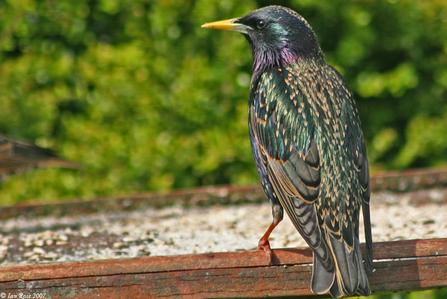
© Ian Rose
The starling is a familiar bird of farmland, parkland, gardens and towns. They eat insects and fruit and will visit bird feeders. Adult starlings have beautiful, onyx black feathers with an iridescent purple and green sheen. In the winter, they are covered in tiny beige spots. Young starlings are a dark grey-brown colour.
You may be lucky enough to witness a mesmerising murmurations this winter. Enormous winter flocks of starlings can number more than a million birds. These flocks are predated on by peregrine falcons, and the flock can be seen wheeling and diving in one great pattern as individuals try to avoid being caught. As dusk arrives, the starlings set off for their communal roost in one of the most staggering natural spectacles of all. Flocks arrive from all directions, gathering in the skies above their roost sites. As numbers of airborne birds reach into the tens and hundreds of thousands, the “murmuration” (as it’s known) takes on incredible shapes in the sky, contracting and expanding as one flock merges into another, swirling back and forth in ever more complex and beautiful patterns.
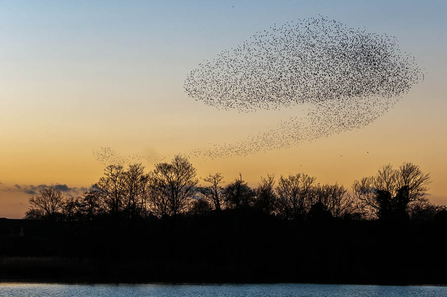
Robert Canis
Our winter visitors
Each autumn, birds arrive at our shores following long journeys to avoid frozen grounds and waters in northern countries and to feast on the more abundant food in the milder climate of the UK. Most migration goes unnoticed by us, especially that of common garden birds, so you might be more familiar with waterfowl and wader species as recognisable migrant birds. Many of these flock to our coastlines during the winter months to feed on a range of food sources, such as molluscs and worms.
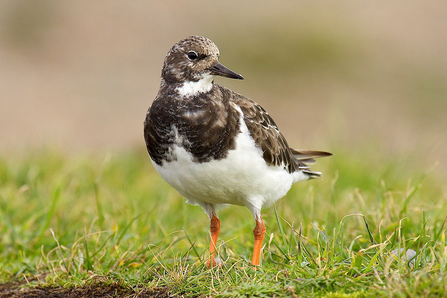
© Fergus Gill
A small but plucky bird often seen exploring shorelines, rooting for crustaceans by turning stones, pecking around seaweed and searching the sand for sandhoppers and gastropods. These birds fly all the way from Canada (around 2,800 miles) which is roughly 70 hours of continuous flight. It is important to give these birds space to feed and rest here during the winter so they can restore their energy, ready for their flight back in the spring. See them at Oare Marshes, Pegwell Bay and South Swale.
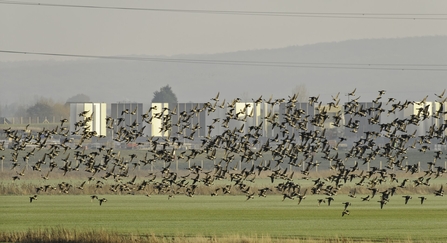
Terry Whittaker/2020VISION
Dark-coloured waterbirds that visit our shores from October to March each year. Flying 3,000 miles from Russia, they come to feast on their favourite food: eel-grass. Around 100,000 geese migrate to the UK each winter and can be seen in large numbers across Kent’s coastlines, particularly at our South Swale reserve, near Whitstable. See them at Oare Marshes and South Swale.
Seals
Why not visit our beautiful Sandwich and Pegwell Bay nature reserve for some seal spotting from a distance. Common seals often gather in large numbers during the winter but please ensure that you do not disturb them by keeping a safe distance and not entering restricted areas. We appreciate you helping us conserve wildlife.
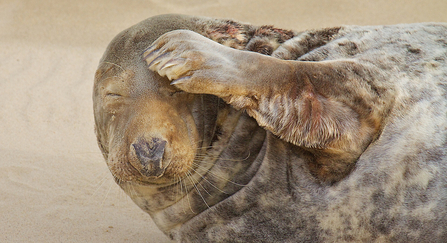
WildNet - David Martin
Lichen forests
Across Kent, hidden forests of lichen are waiting to be discovered. They thrive in almost any environment with enough light, from the rocky mosaics of dry stone walls to the gnarled bark of ancient woodlands. Lichens are fascinating things - not one organism, but a symbiotic coupling of one or more fungus species and an alga or cyanobacterium (or occasionally both). They live in harmony, the fungus providing structure and the other organism making food through photosynthesis. They’re often overlooked, but closer inspection reveals a world in miniature, with lichens growing in sprawling shapes like the trunks, branches and leaves of the forests in which many of them grow. With a searching eye and an open mind, lichens can brighten any winter walk.
In their own quiet way, lichens are some of the most successful of all the winter survivors. One of the reasons lichens can thrive year-round is that they are skilled organic chemists, producing compounds to make their harsh environments livable. Some have antifreeze proteins in their tissues. Some also produce surface proteins that kickstart ice crystal growth, producing an insulating layer of ice. As that external ice freezes, it releases a small amount of heat energy, ever so slightly warming the lichen. On your next winter walk, don’t forget to look beyond the plants to the humble lichens, many of them photosynthesizing against the odds, even in winter.
See the spectacle for yourself...
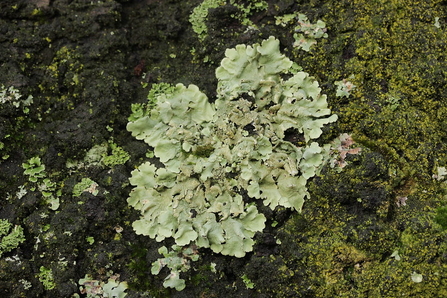
Greenshield lichen
Image credit: Bjorn S, Flickr
Hothfield Heathlands: Kent’s last significant surviving heathland and acid bog. Lichens hide within the sphagnum mosses, hang from the veteran trees and sprawl across the short acid grassland. Species such as greenshield lichen and stone flower are common here.
Ashford Warren: A magnificent area of wood pasture and acid grassland in the heart of Ashford town. The huge veteran trees and sandy soil are home to a range of lichen species. Look out for the skull lichen and hammered shield lichen.
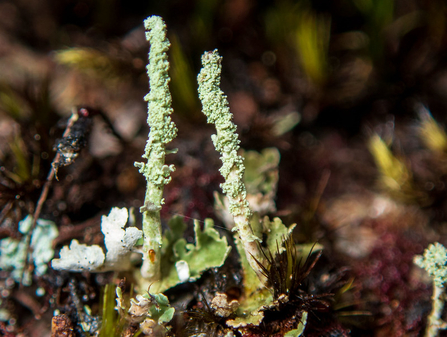
Powderhorn lichen
Image credit: John Turnbill, Flickr
West Blean and Thornden Woods: The oak trees of this beautiful ancient woodland are a great place to look for lichen, and four species are commonly found here including oak moss, pepperpot lichen, common greenshield lichen and common powderhorn. The latter can be spotted on moss covered trunks and often grows on decaying stumps and logs, where it’s greyish-green podetia, or shoots, reach up into the air like tentacles or, as the name suggests, horns.
Sevenoaks Wildlife Reserve: This tranquil reserve is known for its birdlife but look a little closer and you can find some mini marvels. Head to the reserve’s woodland areas to spot nettled shield lichen, black stone flower, and cartilage lichen. Found throughout the northern and southern hemisphere, black stone flower lichen is used as a spice in India.
Snowdrops
The snowdrop is a familiar spring flower, coming into bloom in January and flowering until March. Despite its long history in the UK, it may not actually be native here; it is a native of damp woods and meadows on the continent, but was not recorded as growing wild in the UK until the late 18th century. Nevertheless, it has certainly become naturalised from garden escapees, and white snowdrop ‘valleys’ can now be seen across the county. Plan a lovely day out at our Sevenoaks Reserve and Visitor Centre to find snowdrops, and lots more, this winter. It’s completely free to visit and you can warm up with a hot drink at our lovely café afterwards.
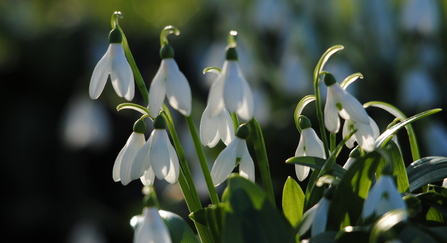
WildNet - Amy Lewis
Look up!
December 21 marks the winter solstice, where the Sun will be at its lowest in the sky, bringing the shortest day with over 16 hours of darkness. To battle the December blues, take this opportunity for stargazing! Thankfully, the winter night sky is full of spectacular sights. The next few weeks also host two of the most prolific meteor showers in the calendar, with the Geminids in December and the peak of the Quadrantids in early January.
The Geminids meteor shower will be visible throughout December, but is expected to peak around 13 and 14 December, and often produces over 100 meteors an hour. More meteors are likely to be visible after midnight, where tiny fragments of rock and dust left behind the 6km (3.5 mile)-wide rocky asteroid known as 3200-Phaethon will hit our atmosphere. This asteroid’s orbit means that every year and a half, it passes close to the Sun, heating up as it does so, and leaves a trail of dust and fragments of rock that Earth passes through every year on its own journey around the Sun.
The Quadrantids is expected to peak around 3 to 4 January. It’s known for producing blue-ish meteors with occasional bright fireballs, so wrap up warm and see if you can spot these meteors blazing through our atmosphere at up to 70km (45 miles) per second!
How can you help?
During the autumn and winter, birds require high-energy (high-fat) foods in the cold weather to maintain their fat reserves to survive the colder nights. At this time of year, please put out food and water on a regular basis. In the case of severe weather, feed twice daily if you can: in the morning and in the early afternoon.
In order to create resilient landscapes, we need dynamic, abundant ecosystems. We must protect our winter visitors to ensure that their vital role in our ecosystem (including feeding on pest species, contributing to seed dispersal and providing natural fertiliser) does not disappear and send shockwaves across our global ecosystem. Please keep away from these feeding birds on coastlines, keep to paths and keep dogs on leads.
